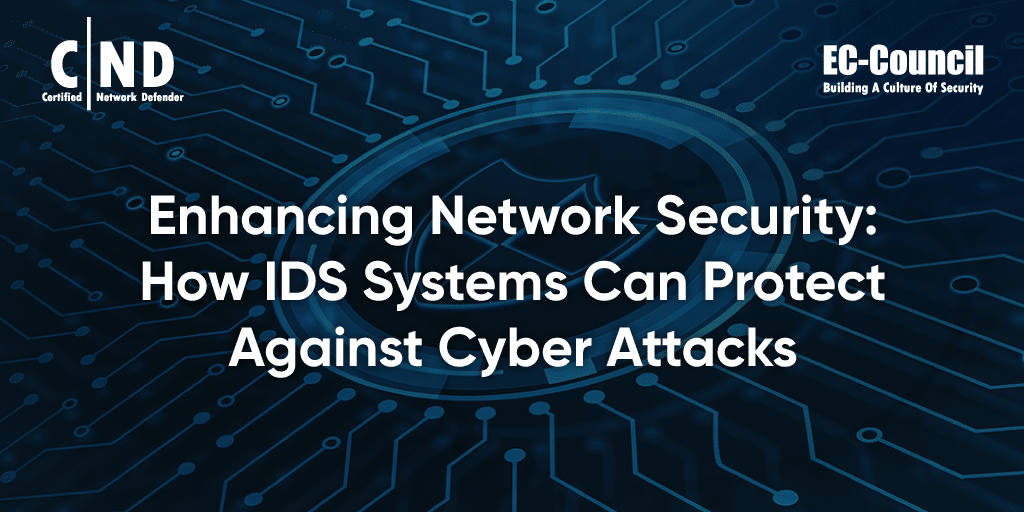Intrusion Detection Systems (IDS) are an emerging solution used for protecting data and safeguard enterprises from a variety of cyberattacks. Modern IDS systems have serious privacy issues and trigger a large volume of noise, false positive alerts, and do not do enough to track suspicious activities in networks. The rise of malicious actors, lack of encryption, and sophisticated attack strategies is overwhelming the cybersecurity landscape which means organizations need to upgrade threat detection methods and techniques. Intrusion detection systems have undergone many developments and been around for decades. They serve as a foundation to network security, help monitor network traffic, and can solve security problems that arise due to unaddressed gaps and vulnerabilities. This paper discusses how to enhance network security using IDS, common challenges faced, and what organizations can do to upgrade their IDS.
IDS to Fight Cyber Attacks
Cyberattacks can disrupt the security of today’s networks and jeopardize the safety, integrity, and reputation of organizations. There is a heightened need for enterprises to safeguard their network security and implement tools and techniques to protect their assets. Intrusion Detection Systems (IDS) are used for surveillance purposes and can secure networks by monitoring traffic for illicit traffic and malicious behaviors.
Network-based monitoring analyzes specific segments, devices, and application activities to detect and identify suspicious behaviors. IDS solutions are critical for organizations as they scan infrastructure systems for vulnerabilities, malware, and policy violations. Intrusion detection systems are different from intrusion prevention systems in terms of capabilities, where the former aims to detect and report incidents, with intrusion prevention systems focused on stopping incidents or causing security breaches.
There are many different types of IDS solutions for enterprises and most of them are customized according to business requirements. Automation in intrusion detection can perform audit trails and identify vulnerability exploits against target applications. Enterprises should upgrade their IDS to proactively detect and respond to emerging network security threats.
This blog will discuss challenges associated with modern IDS and what enterprises can do to upgrade their intrusion detection systems.
Challenges Associated with Modern IDS
Enterprises are continually pursuing faster, more accurate, scalable, and reliable detection frameworks for the latest IDS solutions. Modern IDS solutions present various challenges like unbalanced datasets, low detection rates, poor response times, and more false positives. They also suffer from usability issues and the learning curve is steep for enterprises that are not used to implementing these solutions into their business operations. Security practitioners may also face difficulties when configuring and installing IDS for the first time.
IDS systems generate a high volume of alerts which can be a significant burden to internal teams. Organizations simply don’t have the time or resources to inspect every alert. This means suspicious activity may sometimes slip through the radar.
Common challenges associated with modern IDS systems are:
- Fragmentation – Attackers split payloads by splitting them into multiple packets and staying under the detection radar. Packets sent from one fragment can overwrite data from previous packets, and there are cases where packets are sent in the incorrect order to confuse the IDS system (Jelen, 2023). The IDS solution times out when there are lapses between transmitting data packets or unexpected disruptions.
- Low-Bandwidth Threats – When an attack is spread out across multiple sources and occurs over a long period, it can generate benign traffic and noise, which bear similarities to that of online scanners. False positives and false negatives occur as a result, and there are instances of alert fatigue happening as well, which opens the door to more dangerous threats(Jelen, 2023).
- Obscurity – It manipulates IDS protocols at different ports and evades intrusion detection by confusing the target host (Jelen, 2023).
Top Tips to Upgrade IDS
Upgrading an organization’s IDS begins by taking into account many considerations and making the necessary arrangements. It’s important to factor in an organization’s risk tolerance level when investing in new security measures and ensure minimal exposure to emerging risks. When legacy IDS moves to the Cloud, there is a massive increase in network traffic and network security monitoring tools are expected.
For enterprises that are switching to public and private cloud providers, legacy IDS may not support the latest deployment models. A security information and event management (SIEM) system can help organizations gather information from multiple sources, including intrusion detection solutions, firewall logs, and web applications. Analysis of firewall data can detect unwanted configuration changes, prevent unauthorized access to data, and ensure adherence to the latest compliance standards like DSS, SOX, GLBA, and HIPAA.
In the last few years, Machine Learning and AI have greatly expanded the scope of intrusion detection and prevention, and experts are evaluating the latest IDS techniques to assess the state of organizational security.
AI-Based Detection and Next-Gen Firewalls
AI-based detection is popular for its pattern-recognition techniques and intelligent threat analysis. It can crosscheck intrusion signatures with a signature database that contains older signatures and inspects it to find sequences, commands, and actions in networks which may identify as malware. (Khraisat, 2019)
Increasing the precision of Intrusion Detection Solutions (IDS) is important as threat patterns become increasingly complex. The most common type of IDS deployed to maximize security is the NIDS which is based on ruleset and protocol violation techniques. There are new approaches to identifying network attack events and machine learning techniques can assist with zero-day attack prevention and false-positive reduction in large-scale enterprises, thus preventing attacks in the early stages. (Regino Criado, 2022)
Next-generation firewalls (NGFW) can deep filter threats and enable micro segmentation in networks for effective intrusion prevention. They usually come as standalone products and most next-gen firewalls are integrated with virtual machines and cloud services. NGFW solutions can feature built-in IDS and IPS and have the ability to receive real-time threat intelligence from external sources. Enterprises can add new security features to them as needed, apply security policies on an application-level, and enjoy quick integrations with existing infrastructure assets. An alternative to using NGFW solutions is using Unified Threat Management (UTM) platforms which serve as a universal gateway and combine multiple security solutions.
Best Practices for Intrusion Detection
A good practice is to use multiple layers of intrusion detection technologies to prevent malicious actors from hijacking systems. There are 4 main intrusion detection approaches employed for this: wireless, network behaviour analytics, host-based detection, and network-based attack detection. Hybrid and ensemble intrusion detection models can provide reduced false positive rates and higher accuracy in anomalous threat detection. Machine learning algorithms and feature selection are popular computing methodologies used to improve the performance of intrusion detection systems. Tree-based algorithms can be used as a base classifier, and bagging and boosting are popular ensemble techniques for evaluating various datasets. They also offer excellent classification accuracy and performance when working with selected feature subsets.(Ngoc Tu Pham, 2018)
IDS research recommends the Bayesian and infinite bounded mixture model for the feature classification of members. It is also designed for IoT environment security and can help classify network activities into abnormal and normal classes. A Support Vector Machine (SVM)is a supervised machine learning technique used for making threat predictions and can be used for non-linear feature mapping (Khraisat, 2019). It’s very effective in high-dimensional spaces and can cluster data before the classification process begins.
Virtual patching should be used to protect and remediate vulnerabilities in critical systems. Most organizations adopt a hybrid cloud model for protecting their data across on-premises and cloud environments. AI-based IDS solutions integrate with multiple security products and offer features such as deep packet inspection, URL and on-box SSL inspection, and advanced malware analysis. Having customizable post-scan actions and policies that can be automated can efficiently help protect organizations from various cyber threats as well. (Micro, 2022)
Integrating IDS and IPS Capabilities Under SIEM
Intrusion Prevention Systems (IPS) are essential for improving network visibility and can help identify potential risks. IPS can detect and block unknown threats in real-time and augment the capabilities of modern IDS solutions. Other advantages include correcting cyclic redundancy check errors, eliminating instances of unwanted network layers, and resolving TCP (Transmission Control Protocol) sequencing issues. SIEM connectivity to IPS and IDS can make significant improvements to enterprise security and enable advanced threat protection. SIEM systems can take data from IPS and IDS to give a comprehensive analysis of an enterprise’s security posture and make accurate vulnerability assessments.
Many businesses are relying on managed security services providers (MSSP) to better manage their SIEM systems and ensure regular updates. Detecting and reacting to threats aren’t enough and intrusions start with simple vulnerabilities like outdated software, open ports, and unrestricted limits to login attempts. Persistent malware intrusions are subtle and don’t trigger alarms and careless practices at work like overusing privileged accounts, visiting unsafe websites, and remaining logged in for long periods of time, can set up organizations for new data breaches. SIEM solutions combined with IPS and IDS can detect such habits, tighten security, and prevented unusual account usage patterns, thus helping enterprises prevent cyberattacks and improve security effectively. (Miller, 2020)
Monitoring north-south traffic in cloud-based infrastructures is increasingly important as applications are deployed over multiple data centers and cloud platforms. Enterprises should use VPN to control the flow of north-south traffic and implement the Secure Socket Layer (SSL) protocol to encrypt data transmitted between clients and servers and secure connections. East-West traffic security monitoring inspects activities that occur laterally within network perimeters and mitigates risk for distributed operations. The best practices for efficient east-west IDS security are – applying network segmentation and performing granular inspection of East-west traffic using policy-based controls. Advanced malware analysis and sandboxing will also prevent zero-day attacks and provide accurate threat detection in the process.
Conclusion
IDS capabilities in attack detection depend on simplifying large datasets and selecting the most influential features to improve its model’s accuracy and performance. Different IDS algorithms can dramatically improve the performance of intrusion detection systems, and it’s clear that ML algorithms like DT, KNN, ANN, BN, and SVM all offer unique characteristics and features that enable IDS optimization and enhancement. When IDS is combined with machine learning and AI, its accuracy in detecting R2L and DoS network-based threats dramatically increases. The speed of the training and testing process is another significant factor in improving IDS models, along with the appropriate selection of parameters to improve detection accuracy. Enterprises can also adopt the approach of hybrid data optimization based on ML algorithms and use data sampling techniques to isolate outliers. With the proper modeling strategy, IDS performance can be upgraded, uncover hidden threats in real-time, and detect unknown types of anomalous behaviors in networks as well.
Reference
Ansam Khraisat, I. G. (2019, July 17). Survey of intrusion detection systems: techniques, datasets and challenges. Retrieved from SpringerOpen: https://cybersecurity.springeropen.com/articles/10.1186/s42400-019-0038-7
Jelen, S. (2023, July 20). Intrusion Detection Systems: Types, Detection Methods and Challenges. Retrieved from SecurityTrails: https://securitytrails.com/blog/intrusion-detection-systems#content-challenges-of-intrusion-detection-systems
Micro, T. (2022, December 13). Intrusion Detection & Prevention Systems Guide. Retrieved from Trend Micro: https://www.trendmicro.com/en_us/ciso/22/l/intrusion-detection-prevention-systems.html
Miller, J. (2020, December 15). IDS vs IPS vs SIEM: What You Should Know. Retrieved from BitLyft: https://www.bitlyft.com/resources/ids-vs-ips-vs-siem#security-problems-solved
Ngoc Tu Pham, E. F. (2018, January 29). Improving performance of intrusion detection system using ensemble methods and feature selection. Retrieved from ACM Digital Library: https://dl.acm.org/doi/10.1145/3167918.3167951
Regino Criado, S. I. (2022, December 26). Increasing the Effectiveness of Network Intrusion Detection Systems (NIDSs) by Using Multiplex Networks and Visibility Graphs. Retrieved from MDPI: https://www.mdpi.com/2227-7390/11/1/107
Tags
About the Author











